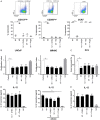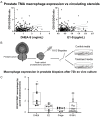Sex steroid modulation of macrophages within the prostate tumor microenvironment
- PMID: 35528461
- PMCID: PMC9077148
Sex steroid modulation of macrophages within the prostate tumor microenvironment
Abstract
Background: The role of androgens and other sex steroids is known to influence the prognosis and progression of prostate cancer through different disease states. While androgens are generally regarded as immunosuppressive and estrogens as inflammatory, the specific influence of sex steroids on the immune microenvironment of prostate tumors remains incompletely understood.
Material and methods: In this study, we evaluate the link between sex steroids and prostate cancer immune cells, particularly macrophages. Using in vitro and in vivo models, as well as ex vivo culture of patient prostate tissue, we evaluated the influence of androgen, estrogen, and progesterone on immune cells of the prostate microenvironment.
Results: In vitro, we observed sex steroids induced indirect changes on prostate cancer cell proliferation via THP-1 derived macrophages, but no clear changes were induced using human monocyte derived macrophages. Comparing immunohistochemistry for immunosuppressive macrophage marker CD163 with concomitant circulating sex steroids from the same patients, we observed a correlation with higher dehydroepiandrosterone (DHEA)-sulfate and estrone-sulfate levels associated with higher prostate CD163 expression. Similar relationships between DHEA and CD163 levels were observed in ex vivo cultured prostate biopsies. Finally, in a murine prostate cancer model of long-term sex steroids we observed significant differences in tumor growth in mice implanted with estrogen and DHEA diffusion tubes.
Conclusions: Our results highlight the complex influence of sex steroids on the immune cell composition of prostate tumors. Understanding this biology may help to further personalized therapy and improve patient outcomes.
Keywords: Prostate cancer; immunosuppressive phenotype; macrophages; sex steroids; tumor microenvironment.
AJCEU Copyright © 2022.
Conflict of interest statement
None.
Figures




Similar articles
-
Sex steroids in the tumor microenvironment and prostate cancer progression.Endocr Relat Cancer. 2018 Mar;25(3):R179-R196. doi: 10.1530/ERC-17-0493. Epub 2018 Jan 9. Endocr Relat Cancer. 2018. PMID: 29317479 Review.
-
Using ex vivo culture to assess dynamic phenotype changes in human prostate macrophages following exposure to therapeutic drugs.Sci Rep. 2021 Sep 29;11(1):19299. doi: 10.1038/s41598-021-98903-y. Sci Rep. 2021. PMID: 34588590 Free PMC article.
-
All sex steroids are made intracellularly in peripheral tissues by the mechanisms of intracrinology after menopause.J Steroid Biochem Mol Biol. 2015 Jan;145:133-8. doi: 10.1016/j.jsbmb.2014.06.001. Epub 2014 Jun 9. J Steroid Biochem Mol Biol. 2015. PMID: 24923731 Review.
-
DHEA, important source of sex steroids in men and even more in women.Prog Brain Res. 2010;182:97-148. doi: 10.1016/S0079-6123(10)82004-7. Prog Brain Res. 2010. PMID: 20541662
-
Six-month oral dehydroepiandrosterone supplementation in early and late postmenopause.Gynecol Endocrinol. 2000 Oct;14(5):342-63. doi: 10.3109/09513590009167703. Gynecol Endocrinol. 2000. PMID: 11109974 Clinical Trial.
Cited by
-
Preclinical models of prostate cancer - modelling androgen dependency and castration resistance in vitro, ex vivo and in vivo.Nat Rev Urol. 2023 Aug;20(8):480-493. doi: 10.1038/s41585-023-00726-1. Epub 2023 Feb 14. Nat Rev Urol. 2023. PMID: 36788359 Review.
-
Tracing the Evolution of Sex Hormones and Receptor-Mediated Immune Microenvironmental Differences in Prostate and Bladder Cancers: From Embryonic Development to Disease.Adv Sci (Weinh). 2025 Apr;12(13):e2407715. doi: 10.1002/advs.202407715. Epub 2025 Feb 25. Adv Sci (Weinh). 2025. PMID: 40007149 Free PMC article. Review.
References
-
- Paschalis A, de Bono JS. Prostate cancer 2020: “the times they are a’changing”. Cancer Cell. 2020;38:25–27. - PubMed
-
- Huggins C, Hodges CV. Studies on prostatic cancer. I. The effect of castration, of estrogen and of androgen injection on serum phosphatases in metastatic carcinoma of the prostate. CA Cancer J Clin. 1972;22:232–40. - PubMed
-
- Hanahan D, Coussens LM. Accessories to the crime: functions of cells recruited to the tumor microenvironment. Cancer Cell. 2012;21:309–22. - PubMed
LinkOut - more resources
Full Text Sources
Research Materials
